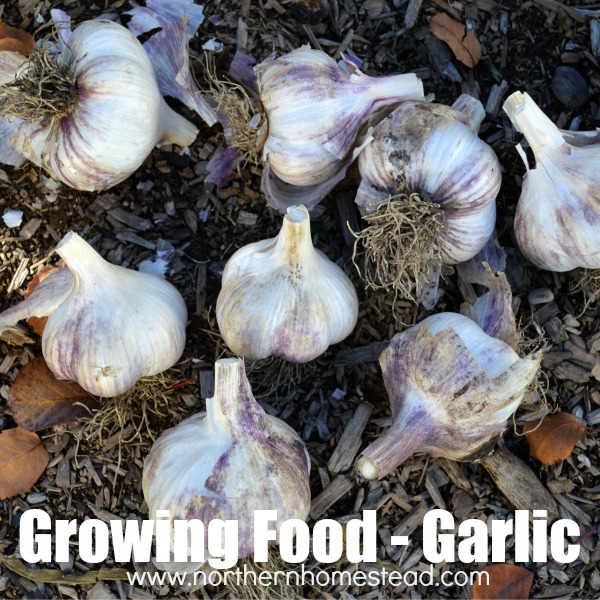
If you enjoy growing your own food, garlic is an essential crop to have in your garden. Read on to learn how to plant, grow, harvest, store, and use this superfood. Garlic is easy to cultivate and can greatly enhance the flavor of many dishes. While some people have a stronger affinity for garlic than others, it offers health benefits for everyone. Since high-quality garlic can be quite expensive, growing your own is definitely worthwhile.
What garlic varieties to grow
Many varieties of garlic exist for different climates. In stores, you will mostly find soft-neck garlic (artichoke), but in our cold climate, we cultivate hard-neck garlic, which features a hard stalk in the center.
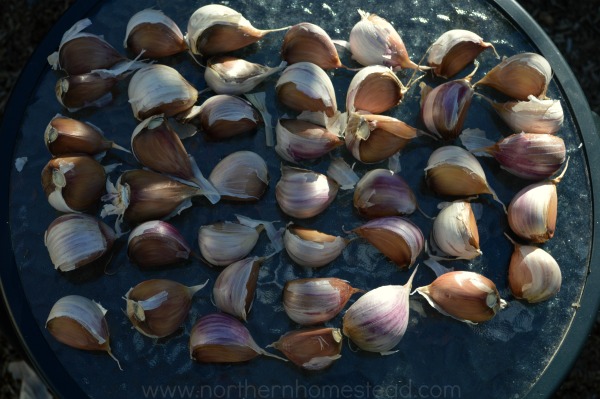
Russian Red, Music, or White are great varieties of garlic to grow in cold climates. I get the garlic I use for planting from a local farmers’ market, and I know this garlic will thrive in our environment. However, I’m not always certain about the variety.
If you’re new to growing garlic, I encourage you to find some locally that you enjoy. You can eat some and plant the largest and healthiest cloves in your garden. This way, you’ll have your favorite variety fresh from your own garden.
Another option is to buy garlic from a seed company. The advantage is that you’ll receive high-quality, healthy bulbs to grow, as well as a wider variety to choose from. However, be sure that the seed company offers hardy varieties that are suitable for your climate. You can read more about obtaining seeds for the new growing season here.
When to plant garlic
In a cold climate, it’s best to plant garlic in the fall, about 4-6 weeks before the ground freezes. In our Zone 3 garden in Alberta, we typically plant garlic outdoors from late September to early October, before the weather becomes cold and rainy. The warmer your climate, the later you can plant garlic.
Garlic can also be planted in the spring. However, instead of garlic cloves, you will most likely harvest a garlic bulb. If you live in a very cold climate and find it challenging to overwinter garlic by planting in the fall, the bulbs from spring planting are still quite usable. If your fall-planted garlic doesn’t come up in the spring, or if you haven’t had a chance to plant it in the fall, don’t hesitate to plant it in the spring.
How to plant garlic
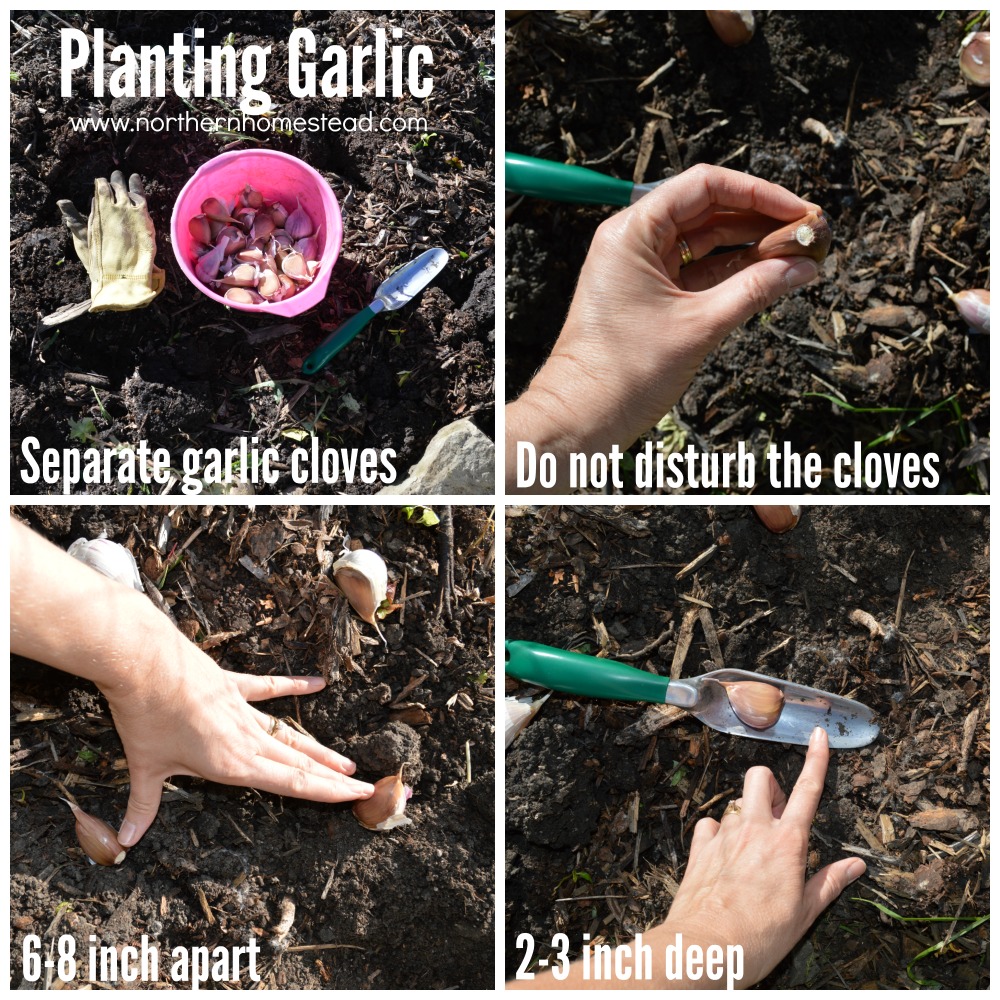
When planting garlic, carefully separate the bulbs to avoid disturbing the cloves, making sure to keep both the upper and lower growing points intact. We recommend planting the garlic 6 to 8 inches apart in all directions. In our cold climate, it’s best to plant the garlic a little deeper, around 2 to 3 inches, with the pointed side facing up. Before winter arrives, we also mulch the soil with compost or wood chips.
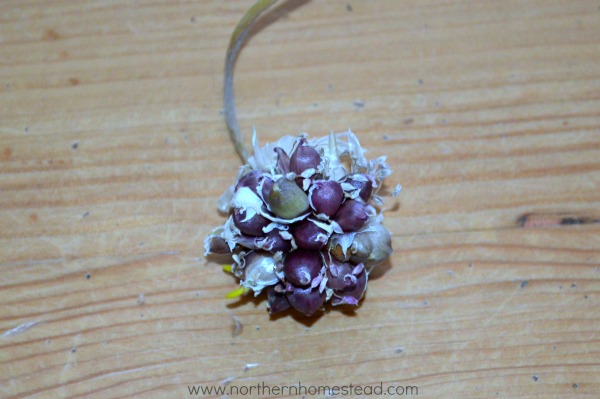
Garlic can also be grown from bulbils, which will take three years to mature into full-size garlic. Here is a video on planting garlic from cloves or bulbils (seeds). If you cannot view the video, please click here.
Harvesting garlic scapes
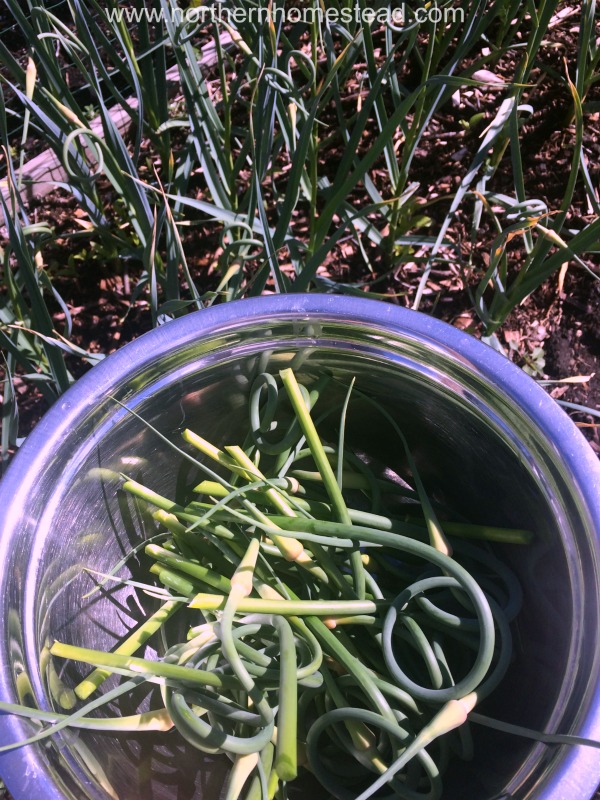
The beauty of hardneck garlic is that it produces garlic scapes. These are small, curly stems that grow from the center of the plant. Eventually, the scapes will develop flowers and produce seeds. It’s important to note that spring-planted hardneck garlic does not produce scapes.
To ensure garlic bulbs grow to a good size, it is advisable to harvest the garlic scapes. The best time to do this is before the bulb starts to open or when the stem becomes woody. Harvest the scapes while they are still green and soft.
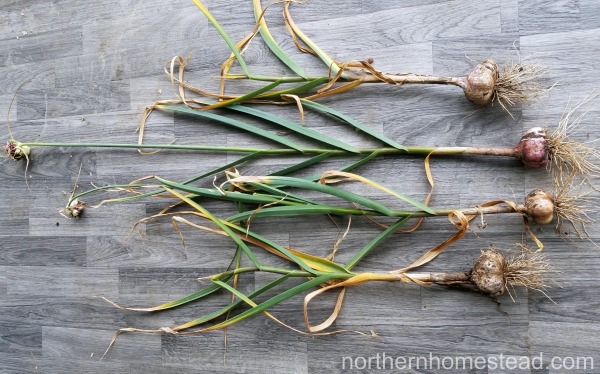
The importance of scape harvesting is evident in this comparison picture. The bulbs that grew without seeds are noticeably larger and healthier. Scapes serve as a fantastic substitute for garlic in summer recipes. They can also be used to make delicious garlic scape pesto (check out our favorite recipes below) or pickled scapes.
Harvesting garlic
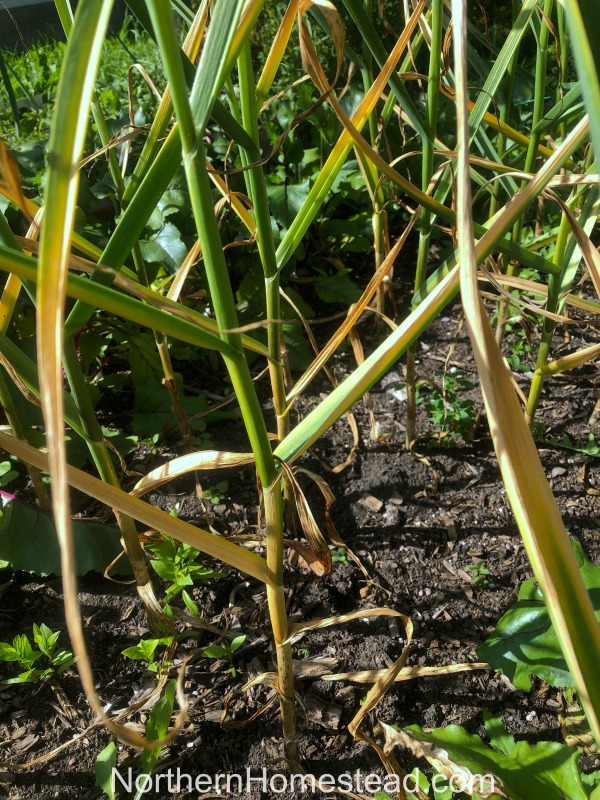
Garlic is ready for harvest when about half of its lower leaves (approximately four leaves) have turned yellow and dried, while the upper leaves remain green. The leaves provide essential protection for the cloves.
If you harvest too early, the skin will be thick, making it difficult for the garlic to dry and store properly. Conversely, if you wait too long to harvest, the cloves may split open, dry out, or begin sprouting due to insufficient protection.
To harvest, gently loosen the soil with a fork to avoid disturbing the bulb. If the soil is very loose, you can simply pull the garlic by the stem.
Curing Garlic
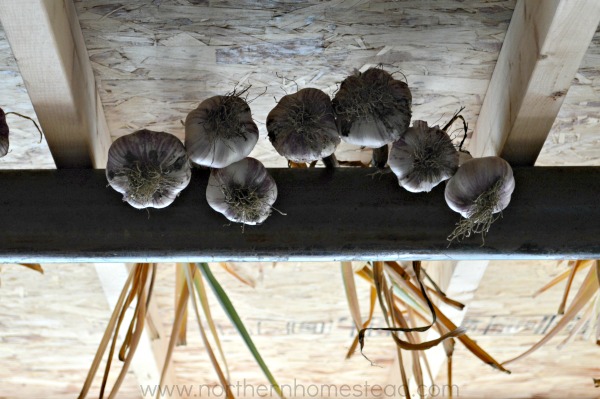
After harvesting, it is important to cure (dry) the garlic before replanting or storing it. Hang or lay the garlic out in a well-ventilated area, away from direct sunlight, and allow the bulbs to dry completely.
Once dried, cut the stem, leaving about an inch, and trim the roots. Your garlic is now ready for storage.
Note: If some garlic bulbs were still green at the time of harvesting, it is best to separate them and use them first, as improperly dried garlic does not store well.
Storing garlic
Garlic differs from most root vegetables because it is planted in the fall, in cold and moist soil. These conditions are ideal for garlic to begin growing. Conversely, for storing garlic, we want to create the opposite conditions.
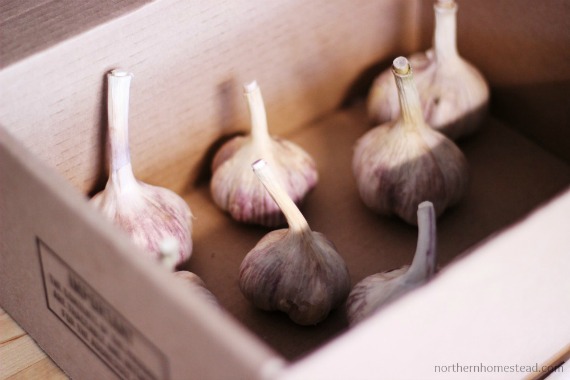
For storage, choose healthy, dry garlic, ideally with larger cloves. If the garlic is not dry, it can mold or begin to sprout, so make sure to cure it first.
We have stored our garlic in a closed cardboard box, which provides a dark and dry environment with some air circulation. The box was kept in the basement (not in the cold room), where it is slightly cooler and darker than the rest of the house.
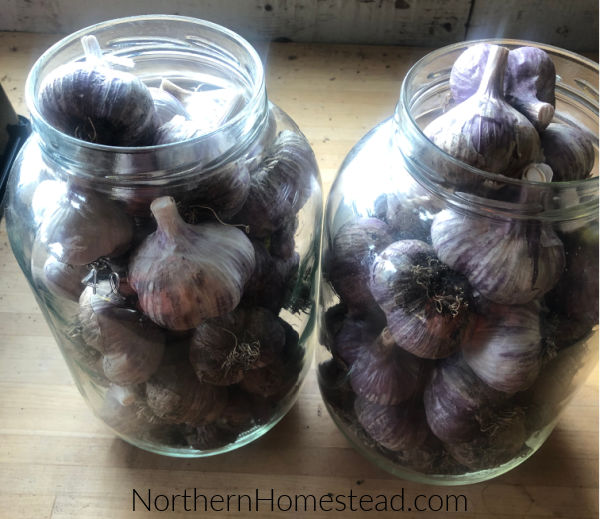
I learned from a Russian video that storing garlic in an open glass jar works even better than other methods. Since then, I have used this technique exclusively. The jar remains open to allow air in, which helps preserve the garlic just as effectively as a cardboard box. I keep it in our heating room in the basement and often still have garlic at planting time.
Tip: It’s a great idea to leave a note in the garlic jar indicating how many garlic cloves you’ve planted. This way, at the end of the season, you’ll know if you want to increase or decrease that number for your next planting.
Using garlic
Garlic is not only delicious but also very healthy in various forms—fermented, raw, or cooked—to enhance the flavor of many dishes. Create your own health remedies, such as Fire Cider.
Using and Preserving Garlic Scapes
Plant-based garlic scape pesto recipe
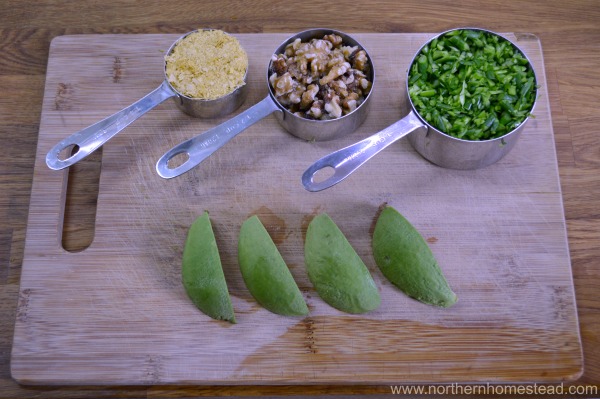
Here is a whole-food, plant-based recipe for garlic scape pesto.
1 cup chopped garlic scapes
1/2 cup walnuts
1/3 cup nutritional yeast
1 avocado
Combine everything in a food processor and process till the pesto is creamy.
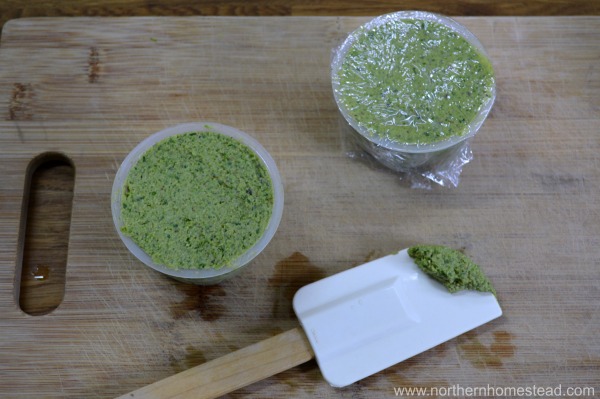
To store, place a plastic wrap right on top of the pesto; this way, it will not turn brown.
Freezing garlic scapes
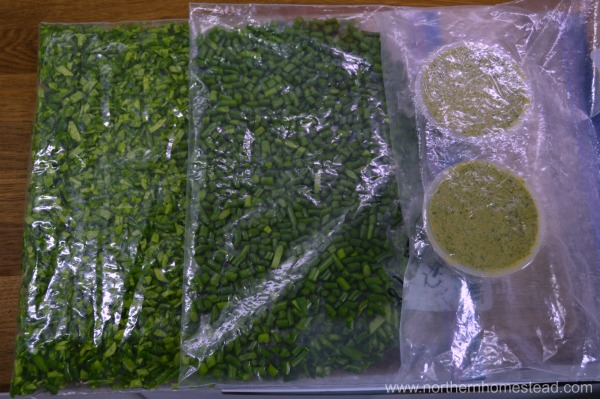
Finely chopped for pesto, or cut for stir-fry and soups, or even the ready-made pesto can all be frozen.
We invite you to subscribe to Northern Homestead and follow us on Instagram, Facebook, or Pinterest for the latest updates.

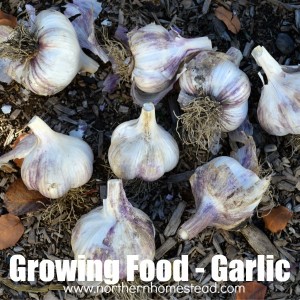
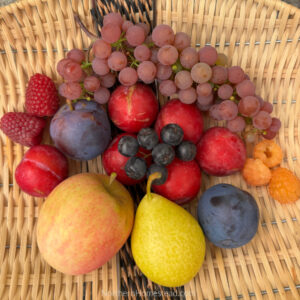
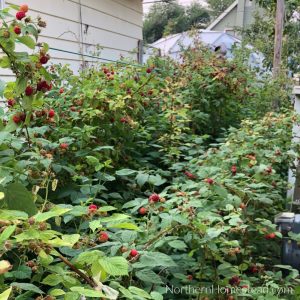
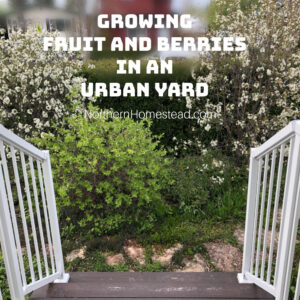
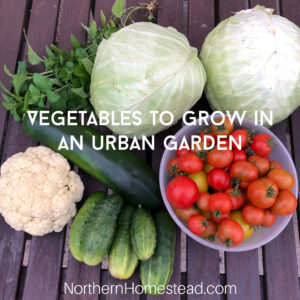
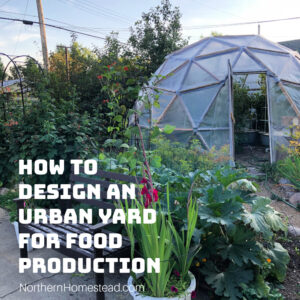
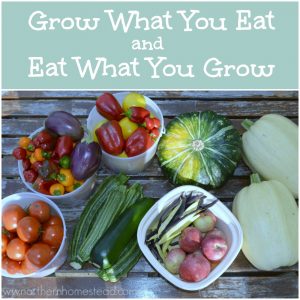
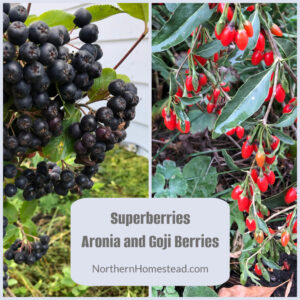
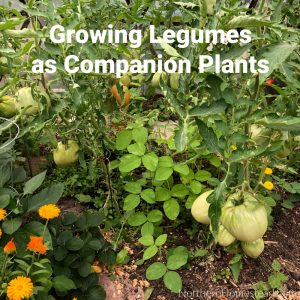
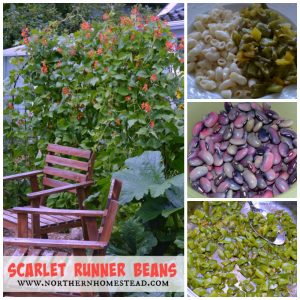

Hi. Thank you for your info. Do you plant your September garlic crop outside in the garden soil? Your photo shows a bin in the greenhouse.
I’d like to plant some in my outdoor raised bed (Central Alberta ) We have an infestation of meadow voles this year and so after planting, all i can think of to keep the voles out is to cover the soil with chicken wire and weight it with stones. Do you have any other ideas or comments? Thank you.
Yes, we grow garlic outside and plant it in September. The bulbils are also can be planted outside. I just planted some in the greenhouse for garlic chives and to see what they will do. If you can, plant your garlic cloves today before the rain. The chicken wire sounds like a good idea to me.
I grew some garlic last year, this year my hubby ate my starter bulb, and I was thinking of trying them indoors. Have you tried that or do you have links to tips,tricks and advice on garlic inside?
There is something about the dormancy that garlic needs by being outdoors. That’s why we plant garlic in in the fall, not in spring. If you grow garlic indoors, it will not produce cloves, just a bulb. You are much better of planting your cloves in the fall outdoors.
Yes. Music is all the rage now. Fat bulbs compared to my Russian red and Persian star varieties. But not nearly as flavourful. But it looks better at the market so I guess that’s how it goes. I did half my beds with music last year, the rest with German, Russian and my exotic heirlooms. Music jumps off the shelf but I don’t care. This is about more than sales volume.
Thanks for your helpful posts.
I grew garlic for the first time last year. It did so well I did it again 🙂 I planted music and another variety I got from a local grower. I love the music’s big bulbs and flavour. Now that I realize I can grow garlic (zone 2) I think I want to try a few more kinds.
This is my 3rd year planting garlic (zone 3 Manitoba). I got my seed from John Boy Farms which is a Manitoba grower with several varieties. Tried Chesnok Red, Red Russian, and Sicilian Gold (a soft neck variety). I tried the soft neck variety because most sites say it will keep longer than the hard neck. It dried down much quicker than the hard necks. We’ll see how it keeps.
One question for you Anna. You said you planted your garlic in September. I usually wait until well into October. Do you find that you get bigger bulbs if you plant earlier?
As usual, I appreciate having a blog to visit that focuses on zone 3 gardening. Thanks for the info!
Interesting experience with soft neck garlic, thank you for sharing. Here in Alberta we can not guaranty that the weather stays warm till October. We might have a deep freeze before that. You want to plant garlic before the ground freezes. I do not think that it effects the size though as long as you plant before frost and snow.
We just planted our garlic last night in a raised bed against our house in Calgary. We added compost and covered with about 2” of leaves.
A few questions:
Is it adviseable to water the garlic after planting? If yes, should we move the leaves off before watering? (The soil was damp but not wet when we planted the garlic).
Lastly, is it OK to have the leaves (for mulch) covering the garlic or should we wait a few weeks to put leaves on?
I do not think there is a right or wrong in your questions. Either way is fine. Personally, I would not water and just leave it as you already did it. Leaves, however, do not make the best mulch to grow in. 2 inches of it might be compact by spring. I would monitor it and make sure you don’t have a compacted layer in spring where the garlic has a hard time to get through. Or just mix in some compost or woodchips into the leaves covering now, that will prevent it from becoming compacted and it should be fine.
Hi Ann,
Thanks for all the important information on garlic with its pictures etc. It was sweet of you do that so other person can learn from your experience.
Regarding Garlic, As I live in Kitchener I plant my garlic in October. This year my garlic was not so big, athough I rotate my garlic every year in different places. But the cloves were very big so the garlic bulb did not turn out like last year. Well I am going mulch the ground and put new earth and see next year if the bulb get bigger. Thanks and enjoy your last two keep of summer of love almas..
Hi Anne!
I am a VERY new gardener and started in February of this year! Neither my mother nor I have ever planted garlic but a gentleman down the street from her told her to break apart a head of garlic and sink it into the ground.. so that’s what we did. I noticed in your video you said to wait until 4-6 weeks before the first Frost. We did this in June! My question to you is, what do you suggest I do now? I have 16 little (about 2 inch tall) stems poking up. Do i now leave them until spring? Any help or advice would be great! Thank you!
Hi Andrea, welcome to the gardening world. Garlic is very easy to grow, and a great beginner plant. Let your garlic grow till fall, then harvest one and see what happened. Most likely you will harvest a bulb, not cloves. If it’s a good size you can enjoy it. The bulb is completely edible, just like normal garlic. If the bulb is small, not much more than a clove, leave them in the ground till next year, you will get cloves next summer. Otherwise, get new cloves and plant them 4-6 weeks before the ground freezes. Hope this helps.
First … where are you located?
I would like to purchase some soft neck garlic for spring planting.
I live on a farm about an hour east of Edmoton, near Vegreville.
I have grown a soft neck variety with great success for many years.
I was told it was a variety the pioneers from Ukraine brought with them in 1897.
However, last year it was very wet all year and I lost it all.
Thanks
Ken
Sorry, you lost your garlic. For a while, I thought soft neck garlic did not grow here, but I’m learning otherwise. We still plant as usual our hard neck garlic which works well for us. We are about an hour north of Calgary.
Hi Anna. I love all the stuff you share 🙂 I am relatively mew to growing garlic here in Grande Prairie. I look daily for sprouts in the raised bed, and so far, May 9, there are just 9 coming up, out of the 50ish I set in October. Can you weigh jn? Is this normal ? I hope I will get a few more.
Thanks Anna!
Since 9 of the 50 are up, I would think that more should come if you planted them all the same. Give it some time. However, I can’t say for sure, hopping for you that you get a great garlic year.
Oh thank you for the reply Anna 🙂 I guess I’ll wait and hope.